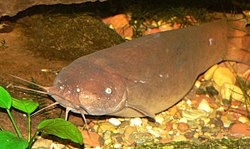Electric catfish
| Electric catfish | |
|---|---|
 | |
| Malapterurus electricus | |
| Scientific classification | |
| Kingdom: | Animalia |
| Phylum: | Chordata |
| Class: | Actinopterygii |
| Order: | Siluriformes |
| Family: | Malapteruridae Bleeker, 1858 |
| Genera | |
| Malapterurus Paradoxoglanis | |
Description
Malapteruridae is the only group of catfish with a well-developed electrogenic organ; however, electroreceptive systems are widespread in catfishes.[4] The electrogenic organ is derived from anterior body musculature and lines the body cavity.[3] Electric catfish do not have dorsal fins or fin spines. They have three pairs of barbels (the nasal pair is absent).[3] The swim bladder with elongate posterior chambers, two chambers in Malapterrus and three in Paradoxoglanis.[3]It is one of the few electric species that have been conditioned by means of reward to discharge on signal. As reported in the New York Times, April 2, 1967, a researcher, Dr. Frank J. Mandriota of City College, NY, conditioned an M. Electricus to discharge on a light signal for a reward of live worms delivered automatically. This is a first in conditioning that modified neither glandular nor muscular responses.
They can grow as large as 100 centimetres (39 in) SL and about 20 kilograms (44 lb) in weight.[3][2] All Paradoxoglanis species are much smaller.[3] Most malapterurids are dwarf species less than 30 cm (12 inches) long.
Relationship to humans
The Nile fish was well known to the ancient Egyptians. Stories say that the Egyptians used this type of catfish when treating some nervous diseases. They would use only smaller fish, as a large fish may generate an electric shock of up to 300 or 400 volts. The Egyptians have depicted the fish in their mural paintings and elsewhere; the first known depiction of an electric catfish is on the slate palette of the pre-dynastic Egyptian ruler Narmer, about 3100 BC.[4] An account of its electric properties was given by an Arab physician of the 12th century; then as now the fish was known by the suggestive name of Raad, abo el ra3ash,el ra3ad or Raash, which means thunder (literally trembler, shaker).Though the shock an electric catfish can generate is not known to be fatal to humans,[2] the catfish does use its electricity as a weapon to ward off predators and to kill its prey.
No comments:
Post a Comment